Work done several years ago suggested that the pole was originally centered around Hudson Bay. Certainly that appeared to be the likely center of the Ice mass itself because of the depression of the Bay. Yet that was a first rough estimate with no clear road to refine the location. Work then did rely on alignments also. It is completely plausible that error worked itself into the analysis.
What we now have is a superior thought provoking analysis of pole locations that is rotated thirty or more degrees to the East in Greenland. It also provides a fifteen degree shift south instead of a thirty degree shift south. none of this is fatal to understanding the consequences and solves the big problem of why no Ice Cap remnants exist elsewhere as they should.
The actual movement stroke is also far better placed to release the energy potential into the North Atlantic itself sub parallel to the Mid Atlantic ridge. A substantial pulse would have entered the Southern Oceans and dissipated into the Pacific and then flow back over time. The Northern Coast of South America would have been deeply flooded but that would have been the worst of it. all in a far safer stroke than i imagined several years ago.
I suspect it will also explain the tectonics better by been better centered or simply located for both the Himalayas and the Andes. In the meantime, are we secure in out dating of 12,900 BP? That happens to be a consistent carbon date from a huge number of data points establishing the carbon dust horizon.. .
Why is Greenland Covered in Ice?
Greenland is covered with a massive ice sheet while Alaska, Canada
and Russia are not. Why? 'N' is where the current North pole is located.
| Source
Why is There an Ice Sheet on Greenland?
Greenland
is the largest island on earth, situated east of Canada, between the
Arctic and Atlantic oceans. About 80% of the island is covered by the
massive Greenland Ice Sheet with an average thickness of about 1,667
meters. If this ice sheet would melt completely off, the sea level will
rise with about 7 meters (23 feet).
Drill samples have shown that the Greenland ice sheet is
approximately 110,000 years old. Other estimates claim that the ice
sheet is 400,000 years old. How did this ice sheet become so thick,
while the surrounding countries with mountain ranges, like Alaska,
Canada and Russia, have no ice sheet? Even Iceland isn't fully covered
in ice. Moreover is the exact age of the ice sheet unclear. What do we
really know?
This article will explore this issue partially which will be published in a series of articles.
Whiteland or Greenland?
Where
the name Greenland comes from, while it's completely white, is unsure.
But it is said to have come from early Norwegian settlers.
According to the Icelandic sagas, Erik the Red named it Greenland in
an attempt to lure more settlers in search of land and the promise of a
better life. It was maybe also a kind of incantation to make the cold
island more liveable.
Sages and legends often contain parts of some truth. The current
scientific view is that Greenland was actually green some 450,000 years
ago. That's quite some time for a legend to bridge, isn’t it?
What happened to Greenland that it's now covered with an insane thick icecap?
Models Say There Can't be Ice
Greenland's
ice sheet has puzzled scientists for many decades, which have led to
complete ridiculous, even unscientific theories. Geoscientists who are
in the search for a logical and consistent explanation are limited by
their own set of beliefs and institutions. This limitation leads
sometimes to the strangest conclusions.
There have been many reports in the media about the effects of global
warming on the Greenland ice sheet, but there is still great
uncertainty as to why there is an ice sheet on Greenland at all.
There are mathematical models that cover Greenland with an ice sheet,
but they also cover the other continents in ice as well. There's no
model possible that covers only Greenland.
What changed in Earth’s history to make this happen?
Latest Official Version
The
reason for that [the ice sheet] is the interaction of three tectonic
processes. For one thing, Greenland had to be lifted up, such that the
mountain peaks reached into sufficiently cold altitudes of the
atmosphere. Secondly, Greenland needed to move sufficiently far
northward, which led to reduced solar irradiation in winter. Thirdly, a
shift of the Earth axis caused Greenland to move even further northward.
The Fact is: There Are no Conclusive Models Found Yet
There are in fact several competing theories why Greenland is covered in ice, ranging from:
- changes in ocean circulation,
- the increasing height of the Rocky Mountains,
- changes in the Earth’s orbit,
- natural changes in atmospheric greenhouse gas concentrations.
The University of Bristol, funded by the British Antarctic
Survey, claims that none of the posited theories can account for the
thick ice sheet of Greenland. Even the Milankovitch cycles are nowhere
near strong enough to explain the ice coverage of Greenland.
While the results of the computations suggest that climatic shifts
associated with changes in ocean circulation and tectonic uplift did
affect the amount of ice cover, and that the ice waxed and waned with
changes in the Earth’s orbit, none of these changes were large enough to
contribute significantly to the long-term growth of the Greenland ice
sheet.
In other words - none of the current theories appear to be valid.
Try to be honest to yourself. Everyone who has a good intuition sees
immediately that it's strange that on the Northern hemisphere only
Greenland is covered with an ice sheet. Not just a bit of ice. A massive
ice layer, while there's nothing on Alaska, Canada and Russia. ***
Are Temperature Fluctuations Correctly Interpreted?
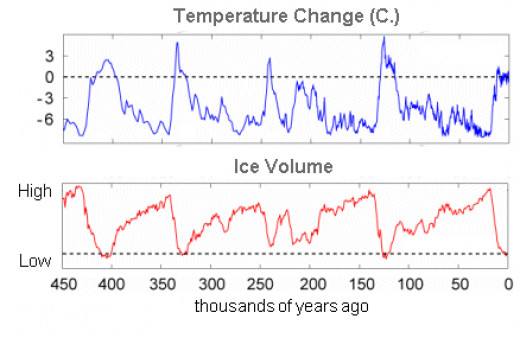
Earth's temperatures have never been constant. But when the
reference points are dislocated the interpretations may be false.
Altitude, the Higher the Colder
Almost
everyone knows that the higher you climb on a mountain, the colder it
becomes. The air gets colder because the air gets less dense, and can
therefore contain less energy. Less energy means less warmth, so it gets
colder.
While we climb higher on the mountain we also get somewhat closer to
the sun, but this effect is so small that it remains unnoticeable and
even unmeasurable.
The sunlight that warms the earth's surface, also warms the air just
above that surface. And most of us know that warm air goes upward,
similar as the effect that we see in a hot air balloon. This warmth
wants to go as high as possible, but is reduced by the effect of the
less denser air, which is ultimately an effect of gravity.
High mountains on Greenland are thought to be the main reason that
the ice sheet has developed, while this has been refuted by the
University of Bristol just recently. ***
No Ice Sheets on Other Mountain Ranges
It
isn't a logical starting point in any case. The ice sheet around the
Greenland Summit, that's about in the middle of the sheet, is about
3,000 meters thick. The altitude is also about 3,000 meters. The
mountains must have been pushed down how much? At which point are they
trading places, or was it a slow sliding scale?
If that would be the main driver, why are there no fat ice sheets on
the Brooks Mountain Range, the Innuitian Mountains, the Mackenzie
Mountains, the Ural Mountains, the Central Siberian Plateau, and the
Verkhoyansk range? Even the mountains on Svalbard aren't covered in
thick ice sheets.
Scientists will probably think of very difficult explanations for
this, but they then tend to forget about Occam's Razor. The simplest
explanation with the least assumptions is the best theory.
The fact is that there is currently still no official theory
available to explain the ice sheet on Greenland, without covering the
above mentioned mountain ranges with an ice sheet as well.
Why no Ice Sheets on Alaska, Canada or Russia?
The latest official
theory why Greenland is covered in ice, includes the assumption that
Greenland was covered with high mountains. These high mountains were
formed by tectonic forces pointed towards the location of Greenland. The
relative thin crust was easier foldable which made the formation of
mountains easier.
The mountain peaks would start to accumulate an ice sheet after
Greenland shifted 18° further up North to its current location,
according to this new theory. It cannot be stated clear enough that this
is completely irrational science.
Why would only Greenland shift Northward? And the rest stays in place? Seriously?
Why this accumulation of ice didn't happen in similar regions in
Alaska, Canada or Russia, where the much colder land climate even more
encourages the build-up of an ice sheet, remains completely out of the
scope of this theory.
This theory seems to be rather adhoc because it doesn't cover the complete subject of ice sheet formation around the Arctic.
-
This database contains the necessary information to calculate the former geographical North poles on the basis of pyramidal alignments. The file can be purchased for $0.99. It contains all the data to evaluate, calculate and verify this conclusion.
Are Earth Crust Shifts Possible?
The
late Professor Hapgood first coined the idea of Earth Crust
Displacements in 1958, and even published complete books and theories
around this issue. Hapgood also explained how crustal shifts were
powered, namely that the deposition of ice around the poles caused
eccentricities. These eccentricities cause a centrifugal force on the
crust and could lead to shifts.
This view is though inconsistent, and not completely in line with
what we see happening today at Antarctica. The centrifugal forces caused
by the ice sheet on Antarctica today is about 2 times larger than the
forces during the last ice age. We would be shifting as we speak. So,
what could power crustal shifts is unsure, but it could be driven by a
combination of inner and outer events.
The fact is that crustal shifts are the only possibility to cover
Greenland with an ice sheet, and that we are now looking at the remains
of crustal shifts. But to claim how this works is yet too early.
.
Never exclude anything in advance. Earth Crust Shifts must
be part of the vocabulary of any sane geologist to explain events that
otherwise become unexplainable. Looking for the cause of the event is
yet another thing, which might be even much harder.
The formation of our world is not only done by one big crustal force, but at least by two:
- Earth Crust Displacements
- Tectonic Plate Movements
How Ice Forms Around the Poles
Ice
has the natural tendency to grow and to melt approximately
concentrically around the poles. This tendency is not influenced by any
wobble, since this wobble still occurs equally around the geographical
pole.
The ice sheet on Greenland shouldn't be there if the geographical
pole always had been were it is today. There is simply no scientific
explanation possible without the introduction of a radical shifting
mechanism of the Earth's crust.
Understanding why the ice sheet was formed on Greenland helps us to
understand the possible response of the ice sheet to future climate
changes, and if the current climate change is completely wrongly
interpreted.
Ice Formation is Concentric Around Poles
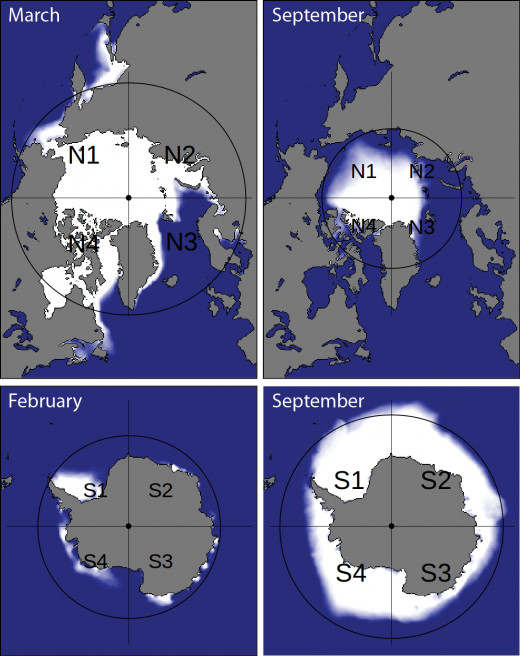
Ice forms concentric around the poles, unless there is a rational mechanism that makes it slightly acentric . | Source
Why Ice Formation is Concentric
The
North pole map at the end of the Winter shows a large amount of sea ice
which is almost centrical formed around the geographical pole. In
winter time, the sea ice in the Arctic ocean gets trapped between
Canada, Russia and Greenland (N1), and forms a dense pack of sea ice.
This pack of ice can't go anywhere, while the ice between Greenland and
Norway floats into the Greenland Sea and the Norwegian sea, and finally
melts. The Gulf Stream plays a major role in this process.
This is the reason why on the North pole the ice is not as symmetrically accumulated as on the South pole.
When we look at Antarctica, we see that the sea ice around Antarctica
can freely float away into the Southern part of the oceans, and is
almost symmetrically formed around the geographical South pole.
The slight acentric accumulation of ice on the South pole is caused
by the predominant ice mass in the sectors S2 and S3, which is a major
chilling factor in the formation of local sea ice.
Last Glaciation Cycle
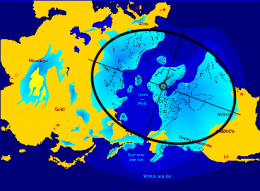
The former glaciation cycle was centred around Greenland | Source
Was the Former North Pole on Greenland?
Science
will never find the mystery of the ice sheet on Greenland, without the
acceptance that the earth crust in its totality, and the tectonic plates
separately, can slide over its liquid core.
The former geographical North pole lied, at the start of the last ice
age about 110,000 years ago, in Greenland. That is the reason why only
Greenland is still covered in ice. The reason why the ice sheet on
Greenland is melting, is because it has been shifted about 1,500 km
South, from its former polar position to its current position.
The ice sheet melts so slowly because Greenland still lies for a
great deal within the polar circle. The outer edges of the sheet are
melting much faster then the elevated centre near Summit. The overall
balance is negative.
The only sure conclusion we can draw is that ice always forms symmetrically around the pole, unless there is a reason, a strong mechanism, that makes it asymmetric.
Which mechanism could have been strong enough to cause such an
asymmetry during the last ice age? Now try to keep the explanations as
simple as possible, without limiting yourself by your own paradigm.
That the former North Pole was located on Greenland can also be proved by calculations.
Milankovitch Cycles (65ºN) Are No Cause of Glaciations
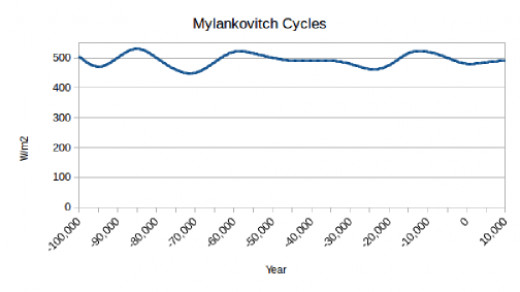
The Milankovitch cycles are believed to be the driver of Ice Ages.
The fluctuations are much too flat to be the main driver of radical
changes. They can however influence our climate depending of the cycle
earth is going through. | Source
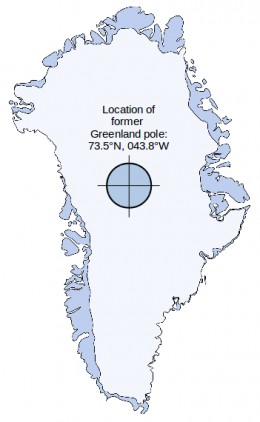
Here was the former North Pole located some 110,000 years ago.
There's less than 0.002% chance that it WASN'T at that location.
Greenland moved in 3 steps over the North pole | Source
Former Pole
Greenland
was situated at the North Pole between 110,000 and 200,000 years ago.
There's even hardly any doubt about the location.
The centre point of the last ice ages is exactly in line with the alignment of more than 110 ancient pyramids.
And that is no coincidence. There is 2.9×10-21 %
(0.0000000000000000000029 %) chance that an arrangement of this
magnitude happens accidentally, which is a sure confirmation of
something very significant.
Our ancestors pointed their structures to a pole that appeared to be at that time at another location - Greenland.
This completely new theory explains in the simplest possible way why there is still a thick ice sheet on Greenland.
This also explains why there's even an ice sheet present, while there's nothing of the ice sheet left on Russia or Canada.
The ice sheet gets thicker the closer we get to the pole. That is what we see on Antarctica today.
The current North pole and the former North pole are shifted under an
angle of about 16°. The former North pole on Greenland was situated at
the location as shown on the map above.
How the Melting Rate of the Ice Sheet Proceeds

The current location of Greenland makes the ice sheet melt on a
very low rate. In about 4,000 years from now it will be completely
molten. The fluctuations in Solar power at 65N is caused by the
Mylankovitch cycles. It plays hardly any role. | Source
The Ice Sheet Will Wax and Wane
Of
course will the ice sheet wax and wane a little bit from year to year,
from decade to decade, or even from century to century. That's because
Greenland has moved to a part of the Arctic where the temperature's
yo-yoing around zero. But the overall picture is clear. It melts
substantially, when measured over a period of a thousand years.
The melting energy comes for less than 0.1% from the airflow, and for
99.9% from the warm Gulf Stream. The Gulf Stream is present around
Greenland to restore the balance after the balance disturbing crustal
shift that happened about 110,000 years ago. The ice sheet melts
therefore from below, and hardly from above.
This melting mechanism has absolutely nothing to do with a greenhouse
effect. The melting process is fueled by (the balance restoring) El
Niño.
The temperatures of the elevated centre part of Greenland is always
far beneath zero, while the lower outer edges of Greenland are nearly
half of the time way above zero. To model this process is not so easy,
even with the understanding what the origin (North pole) of ice sheet
was.
If you would zoom in on the smooth graph above that presents a period
of about 20,000 years you'll find an erratic pattern. Climate sceptics
will try to zoom in on parts of the erratic pattern and claim that the
sheet is growing. That's an obvious wrong interpretation of a long slow
process.
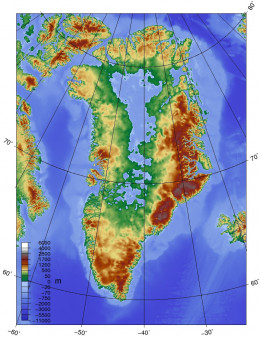
The mass of the massive ice sheet of Greenland has pushed the land
mass of Greenland down, leaving high mountain ranges around it. It
created a kind of 'open shop freezer'. The ice sheet has been trapped
inside. | Source
Original Thickness of the Greenland Ice Sheet
The
fact that the ice sheet on Greenland is still melting, and the former
ice sheets of the last glaciation on Russia, Canada and America are long
gone, means that the ice sheet on Greenland must have been very thick.
The core temperature of the Greenland ice sheet was much lower as
well, because it was situated at the North pole. The other ice sheets on
Canada and Russia weren't as cold as the one on Greenland. The immense
thickness and the very low temperature of the Greenland ice sheet,
combined with its current polar location (it's still cold), makes it
melt at a very low rate.
This ice sheet will melt anyway, whatever we do. Zero Carbon emission
or much Carbon emission. No scientist has ever proven a one on one
relation between CO2 and temperature rise. CO2 is the effect, not the
cause. That should be clear to any smart scientist involved in climate
change.
Calculations, resulting in the graph above, show that the original
ice sheet was 32% thicker when it lied on the North Pole, average around
2,200 meters thick. The thickest part of the ice sheet was centred
around the pole, and was probably between 4,000 and 4,500 meters thick.
Melting Rates of the Greenland Ice Sheet
The Greenland Ice Sheet Will Melt In Any Case
The estimation of the IPCC concerning the current
melting speed of the Greenland ice sheet are in line with the
calculations that will be published in one of the next series of
articles. Only with this difference that the origin of the ice sheet of
Greenland has been determined, and that makes a world of a difference.
The extrapolations of the IPCC concerning the melting rate are exaggerated and based on too many unscientific assumptions.
The ice sheet won't melt within just a few hundred years. There's
even not enough energy to change ice into water, called heat of fusion,
within this short time frame.
When all ice on Greenland is molten into the oceans in about 4,000
years, it will influence the climate on earth dramatically. The risen
sea level will influence all coastlines. The energy that was required to
melt the ice sheet cannot go anywhere else than into warming the whole
atmosphere and the oceans.
The Northern hemisphere will heat up, the Southern hemisphere will
cool down. This is a logical part of earth's balancing mechanism,
otherwise it wouldn't have survived billions of years. But how this
exactly will work out is yet unknown.
Evidence for Earth Crust Shifts
Paleomagnetism delivers proof for crustal shift, although scientists may not even recognize it as such.
Scientists assume when they look at the samples of magnetic pole
reversals, that the magnetic pole was the only variable that changed,
while there's no way to tell from the samples what has changed - the
magnetic pole or the crust.
It was both. To dredge from the data the correct interpretations was a
monumental undertaking. The data will be published gradually in other,
new articles.
The penny still hasn't dropped in many scientists that magnetic
reversals are in fact evidence for Earth Crust Shifts. Only because we
cannot simply solve two variables from just one equation, the assumption
is conveniently made that it was only one variable - magnetic reversal.
That was a tragic error.
Even More Evidence
A next article will show the amazing outlining of 112 pyramids spread around the world to Greenland. These 112 pyramids point to three different clear locations on Greenland.
And exactly at the same point that was already embraced by the ice
sheets of the last glacial cycle. This doesn't only show an amazing
outlining of pyramids around the world, but also that these pyramids are
much older than always assumed.
We can find the exact location of the Greenland pole by performing
spherical triangulations with the alignments of ancient structures
around the world. It has similarities with the way sailors used to find
their way on the seas.
Is it Important to Know?
Why it is important to know that
the former North pole was once on Greenland? Because this notion has a
huge impact on the climate models, and even on the current weather
models.
All models somehow try to explain the presence of the ice sheet on
Greenland from its current position, and not from the position where it
came from, and that the reason is why it is melting in the first place.
As long as the current climate models haven't included the correct
starting parameters, they will all be wrong in their long term
predictions.
This is why it is important to know that the former North
pole was on Greenland. This theme will be explained in an upcoming new
series of articles together with the used data.
A shifting mechanism might have serious implications for the Carbon
dating method as proposed by Libby in 1947, since the biosphere is not
as stable as always assumed. This dating method has become the standard
dating technique for organic materials found around ancient sites.
© 2015 by Buildreps

No comments:
Post a Comment